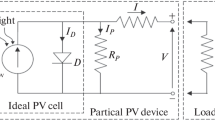Abstract
The purpose of this chapter is to establish a photovoltaic simulation system using mixed programming with LabVIEW and Simulink and compare the simulation results of three maximum power point tracking (MPPT) algorithms for the photovoltaic simulation system. The Matlab/Simulink is used in this chapter to establish the component models of the proposed photovoltaic simulation systems. LabVIEW is responsible for developing the virtual control interface and connects it with Simulink to perform simulation and analysis tasks. The proposed photovoltaic simulation system is developed by combining the models of solar modules and DC-DC boost converter with the tracking algorithms of perturbation and observation (P&O), incremental conductance (INC), and hill climbing (HC), respectively. The system will be simulated and analyzed under different weather conditions and MPPT algorithms. The simulation results will be shown on the interface of LabVIEW by mixed programming method. According to the comparisons of the simulation results, it can be observed that the photovoltaic simulation system can track the maximum power accurately using the three different MPPT algorithms, respectively. The simulation results can also be successfully displayed on the LabVIEW interface. The correctness and feasibility of the proposed photovoltaic simulation system is then validated.
Access this chapter
Tax calculation will be finalised at checkout
Purchases are for personal use only
Similar content being viewed by others
References
Tavares CAP, Leite KTF, Suemitsu WI, Bellar WI (2009) Performance evaluation of photovoltaic solar system with different MPPT methods. In: 35th annual conference of IEEE (IECON ’09), Porto, 3–5 Nov 2009, pp 719–724
Hua C, Lin J, Shen C (1998) Implementation of DSP-controlled photovoltaic system with peak power tracking. IEEE Trans Ind Electron 45(1):99–107
Fangrui Liu, Yong Kang, Yu Zhang, Shanxu Duan (2008) Comparison of P&O and hill climbing MPPT methods for grid-connected PV converter. In: 3rd IEEE conference on industrial electronics and applications 2008 (ICIEA 2008), Singapore, 3–5 June 2008, pp 804–807
Hua CC, Lin JR (2001) Fully digital control of distributed photovoltaic power systems. In: IEEE international symposium on industrial electronics (ISIE 2001), Pusan, June 2001, vol 1, pp 1–6
Xiao W (2003) A modified adaptive hill climbing maximum power point tracking control method for photovoltaic power system. Master thesis, The University of British Columbia, British Columbia, July 2003
Huang SK, Peng YN, Xie SP, Wei DH (2009) Methods and application of mixed programming with LabVIEW and Matlab. Res Explor Lab 27(7):67–71
Vergura S, Natangelo E (2010) LabVIEW-Matlab integration for analyzing energy data of PV plants. In: International conference on renewable energies and power quality, Granada, 2010
Brezina L, Andrs O, Brezina T (2008) NI LabView – Matlab SimMechanics Stewart platform design. Appl Comput Mech 2:235–242
Zhuang J-C (1997) Photovoltaic engineering-solar cells. Chuan Hwa Book CO. LTD, Taipei
Hohm DP, Ropp ME (2003) Comparative study of maximum power point tracking algorithms. Prog Photovolt Res Appl 11(1):47–62
Esram T, Chapman PL (2007) Comparison of photovoltaic array maximum power point tracking techniques. IEEE Trans Energy Convers 22(2):439–449
Lee J-H, Bae HS, Cho B-H (2006) Advanced incremental conductance MPPT algorithm with a variable step size. In: 12th international conference on power electronics and motion control, Poznan, 30 Aug–1 Sept 2006, pp 603–607
Yusof Y, Sayuti SH, Latif MA, Wanik MZC (2004) Modeling and simulation of maximum power point tracker for photovoltaic system. In: Power and energy conference (PECon 2004), Kuala Lumpur, 29–30 Nov 2004, pp 88–93
Author information
Authors and Affiliations
Corresponding author
Editor information
Editors and Affiliations
Rights and permissions
Copyright information
© 2013 Springer Science+Business Media New York
About this paper
Cite this paper
Yu, TC., Lin, YB., Chang, FS. (2013). Establishment of the Photovoltaic Simulation System Using Mixed Programming with LabVIEW and Simulink. In: Juang, J., Huang, YC. (eds) Intelligent Technologies and Engineering Systems. Lecture Notes in Electrical Engineering, vol 234. Springer, New York, NY. https://doi.org/10.1007/978-1-4614-6747-2_46
Download citation
DOI: https://doi.org/10.1007/978-1-4614-6747-2_46
Published:
Publisher Name: Springer, New York, NY
Print ISBN: 978-1-4614-6746-5
Online ISBN: 978-1-4614-6747-2
eBook Packages: EngineeringEngineering (R0)




